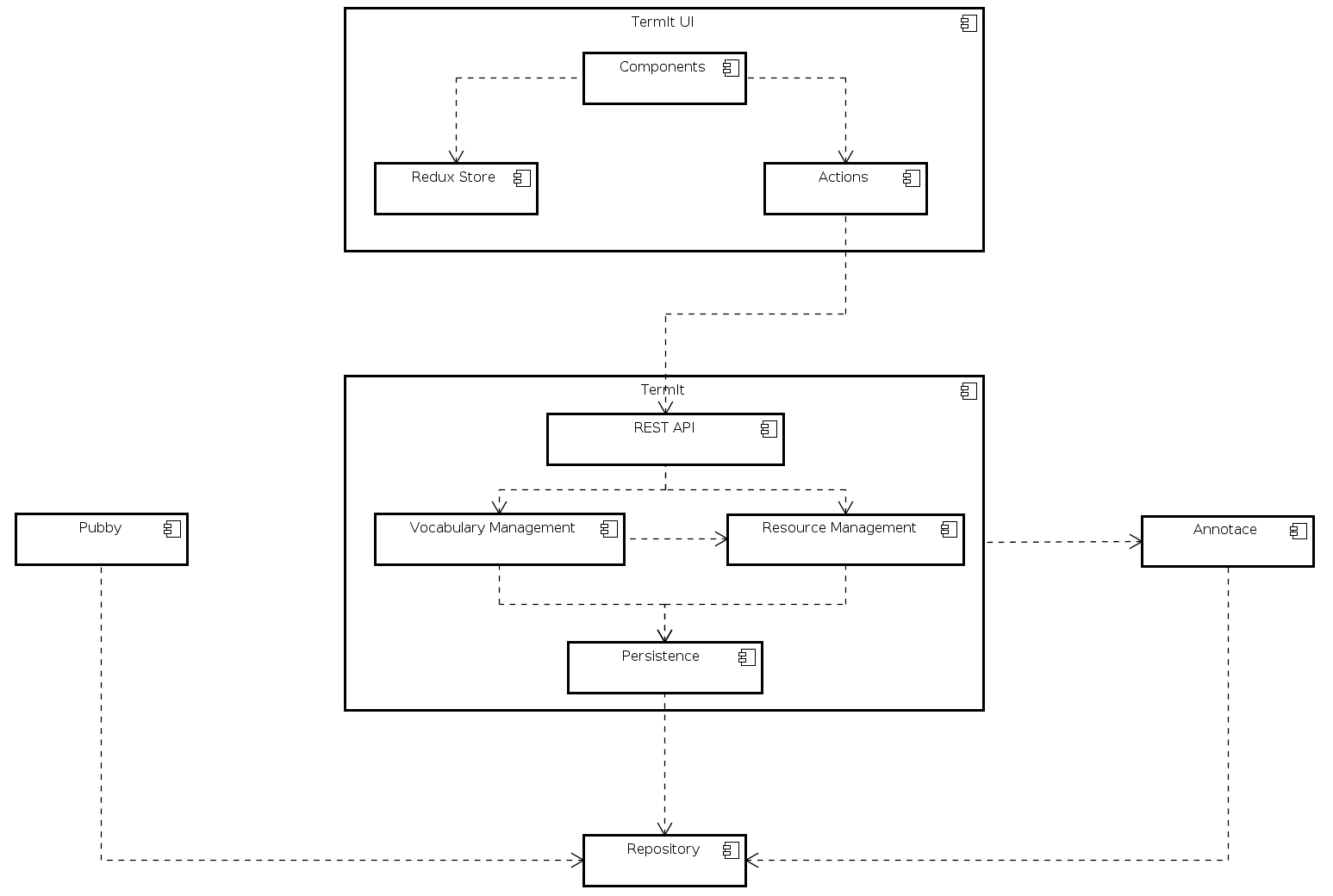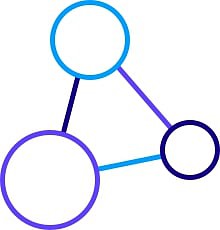Technical Details
This page contains some technical background of TermIt. It describes the architecture of the system, libraries developed by us that it uses, and the data model at its core.
Technologies and Architecture
Technically, TermIt is a system consisting of several services, one of them being a Web application called TermIt. The application is split into two subprojects, one representing the backend (the server side) and the other representing the frontend (the client side). The overall architecture of the TermIt system can be seen in the following component diagram.

Note that the diagram shows TermIt using a separate authentication service. TermIt can also be deployed with internal authentication and user management.
TermIt Backend
The backend is written in Java (17 or later). It is a Spring Boot-based Java web application with a REST API supporting JSON and JSON-LD. TermIt runs on top of a triple store where it stores all its data. We use GraphDB for its superior performance and support for custom inference rules which TermIt utilizes.
Details on how to configure or develop the TermIt backend can be found in its GitHub repository.
TermIt Frontend
The frontend is a client-side Web application written in TypeScript using the React framework. React is used for its simplicity of use and the vast ecosystem of libraries one can utilize.
The frontend source code can be found in its GitHub repository, which also contains some basic developer documentation.
Annotace
One of the most interesting features of TermIt is its ability to analyze the content of documents to find occurrences of terms and suggest new terms based on their significance in the text. The text analysis functionality has been developed separately to enable its reuse. This library is called Annotace, it is also open source and can be found on GitHub as well.
Validation
TermIt supports checking term quality using a set of SHACL rules. Validation is provided by a separate Validation service.
Notable Libraries
TermIt uses several custom libraries and components that may be of interest for other Semantic Web developers. Here is a short list with some basic details and links with more details.
JOPA
JOPA (Java OWL Persistence API) is a persistence library for semantic data. It allows working with a POJO-based domain model which is stored as RDF data in a triple store. Heavily inspired by JPA and its implementation, JOPA contains all the necessary bells and whistles (transactions, query result mapping, caching) to make development of a Semantic Web-based information system as smooth as possible.
There is also a library for integrating JOPA with the declarative
transaction management of Spring (think @Transactional) that is used in TermIt.
JB4JSON-LD
JB4JSON-LD (Java Binding for JSON-LD) is a library for seamless marshalling and unmarshalling of POJOs into and from JSON-LD. It integrates with Jackson, so the setup for an application is a matter of just a couple of lines of code.
Data Model
Vocabularies modeled in TermIt are compatible with SKOS. Two more ontologies are used to cover additional parts of the data model: the Data description ontology and the TermIt ontology, both developed by the Knowledge-based and Software Systems Group (KBSS).
Data Description Ontology
Basic ontology used for description of any data. Its description as well as serialization in various RDF formats can be found on this page. It is based on the Unified Foundational Ontology (UFO). The ontology allows describing any data source, such as databases, data in various formats, files, etc.
The following paragraphs describe the basic classes defined in the model.
Vocabulary
Vocabulary represents an ontology, consists of glossary and model.
Glossary
Corresponding to SKOS ConceptScheme, a glossary is a list (a forest, when taking hierarchies into account) of all terms present in vocabulary.
Model
A model brings ontological relations to the terms defined in the glossary, using mainly UFO.
Term
Corresponding to SKOS Concept, a term is any concept used in the vocabulary.
Source
Source represents the origin of data that are being modeled, e.g., database, data set, document, file, etc…
Attribute
Attribute is a special type of term, representing a property dependent on an object described in a source (e.g., a column in a database table, property described in a document, etc.).
TermIt ontology
TermIt ontology has been created when developing TermIt. It inherits Data description ontology and extends it with concepts used specifically in an application such as TermIt.
Major problems solved by the TermIt ontology regard textual annotations, occurrences of terms in the sources and user management.
The current version of the TermIt ontology is part of the TermIt source code and can be found on GitHub.

